Mathematics Form 1 Chapter 2 Exercise With Answers
Practice Test - MCQs test series for Term 1 Exams
NCERT Solutions for Class 9 Maths Chapter 2 - Polynomials
Find the best ways to practiceNCERT Solutions for CBSE class 9 maths chapter 2 Polynomials. It is one of the crucial chapters for students of CBSE class 9 maths.Polynomial is the second chapter of CBSE Class 9 Maths which includes a detailed explanation of the Polynomial and different factors that include whole numbers, integers, and rational numbers.
The chapter begins with Polynomial in one variable- Linear, Quadratic and Cubic Polynomial, then it is followed by representing Real numbers on the number line, operation on Real numbers and concluded with laws of exponents for Real numbers.
You can go to the NCERTCBSE Class 9 Maths Textbook solutions of a specific chapter by selecting the chapter from our easy-to-use drop-down chapter list. Whether you want to revise an exercise in the chapter on Polynomials or check out Polynomials problems, we have got you covered. TopperLearning'sNCERT solutions allow you to improve your problem-solving techniques, revise formulae, and enable to score more marks.
Exercise 2.1 Page: 32
Learn how to identify polynomials in one variable, find out the coefficient of Polynomial, Degree of the Polynomial and classifying Polynomials as linear, quadratic and cubic with ourNCERT solutions for CBSE class 9 maths. The TopperLearning Expert Team provides the portalUNDOUBT where students can ask all their doubts. These doubts are answered by the academic experts making students understand every step clearly. Students use this portal to get a quick resolution to their questions.
Exercise 2.2 Page: 34
Find the values of the Polynomial, zeroes of the Polynomial and understand real numbers with ourNCERT Solutions for CBSE class 9 maths. The advantage ofNCERT solutions for CBSE class 9 maths is that it helps you solve and revise the whole syllabus of maths class 9.
Exercise 2.3 Page: 40
Learn how to divide a Polynomial by a Polynomial with our best and the easiest ways in our NCERT solutions for CBSE class 9 maths. Thevideo section provides students with all the tutorials that can help students understand different concepts and applications. There are two types of videos-Concept and Application.CBSE Class 9 revision notes will help you brush up with your learning during exam time.
Exercise 2.4 Page: 43
Understand Factor Theorem and determine the factor with TopperLearning resources such asVideo Lessons,Doubt Solver andSample Papers from which you can learn about Polynomials. These resources will help you clarify your doubts and understand how to apply Factor Theorem by identifying its factor.
Exercise 2.5 Page: 48
Learn what suitable identities are and understand how to find out the resulted product with CBSE Class 9 study materials. These includeCBSE Class 9 video lessons, CBSE class 9 maths- All Subject notes, revision notes andCBSE Class 9 Mathematics Sample Papers 2020-21.The test portal of TopperLearning provides students with the question papers and solutions which students can access for exam preparation. Refer to CBSE class 9 most important question where you will get all the questions that have a high probability that they will come in the current exams. Practise fromCBSE class 9 multiple choice questions and solutions with detailed explanations. CBSE class 9 maths textbook solutions provide you with solutions from NCERT textbooks.
Conclusion:
To get good marks, you need to create a plan by first going through the latest syllabus of CBSE Class 9.
Prepare your study timetable for each chapter. Allot time for reading from various study materials and ask doubts on ourCBSE Class 9 doubt solver.NCERT Solutions for CBSE Class 9 will quickly take you through the concepts of each chapter in the CBSE Class 9 syllabus. The next step is to revise the chapters as much as possible.
To score better marks, practise theCBSE class 9 maths sample papers for the numerical questions and application-based questions from our study materials. Don't forget to practise drawing diagrams and graphs and understanding them. If you remember to label your diagrams correctly, you can easily score marks through diagram questions. Reach out to theUndoubt portal in case you have any trouble understanding any questions. Our expert team is always there for you to help you with all your questions. Finally, test your knowledge of CBSE Class 9 topics by using ouronline self-assessment resources.
Readmore
Updated NCERT Textbook Solutions Coming Soon!
Chapter 2 - Polynomials Exercise Ex. 2.1
Solution 1
(i)
Yes, this expression is a polynomial in one variable x.
(ii)
Yes, this expression is a polynomial in one variable y.
(iii)
No, here the exponent of variable t in term which is not a whole number.
So this expression is not a polynomial.
(iv)
No, here the exponent of variable t in term ![]() is -1, which is not a whole number. So this expression is not a polynomial.
is -1, which is not a whole number. So this expression is not a polynomial.
(v)
No, this expression is a polynomial in 3 variables x, y and t.
Concept Insight: In such problems to check whether the given algebraic expressions is a polynomial or not, check the exponents of variable to be a whole number. The second step is to look for the number of variables the expression has. Any alphabet used in the expression is the variable unless specified as constant.
Solution 2
(i)
In the above expression coefficient of x2 is 1
(ii)
In the above expression coefficient of x2 is - 1.
(iii)
In the above expression coefficient of
(iv)
In the above expression coefficient of x2 is 0.
Concept Insight: The constant/ variable multiplied with the variable is the coefficient of the variable. Also consider the sign (+ve or the -ve) of the term while writing the coefficient.
Solution 3
Degree of a polynomial is the highest power of variable in the polynomial.Binomial has two terms in it. So binomial of degree 35 can be written as x35 + 7 . Monomial has only one term in it. So monomial of degree 100 can be written as 7x100. Concept Insight: Mono, bi and tri means one, two and three respectively. So, monomial is a polynomial having one term similarly for binomials and trinomials. Degree is the highest exponent of variable. The answer is not unique in such problems . Remember that the terms are always separated by +ve or -ve sign and not with .
Solution 4
Degree of a polynomial is the highest power of variable in the polynomial.
This is a polynomial in variable x and highest power of variable x is 3. So, degree of
this polynomial is 3
This is a polynomial in variable y and the highest power of variable y is 2. So degree
of this polynomial is 2.
This is a polynomial in variable t and the highest power of variable t is 1. So degree
of this polynomial is 1.
(iv) 3
This is a constant polynomial. Degree of a constant polynomial is always 0.
Concept Insight: Degree is the highest exponent of the variable. While finding the degree of a polynomial express the polynomial in standard form Combine the like terms and Remember the result that xo = 1.
Solution 5
(i) 2 + x2 + x is a quadratic polynomial as its degree is 2.
(ii) x - x3 is a cubic polynomial as its degree is 3.
(iii) y + y2 + 4 is a quadratic polynomial as its degree is 2.
(iv) 1 + x is a linear polynomial as its degree is 1.
(v) 3t is a linear polynomial as its degree is 1.
(vi) r2 is a quadratic polynomial as its degree is 2.
(vii) 7x3 is a cubic polynomial as its degree is 3.
Concept Insight: Linear polynomial, quadratic polynomial and cubic polynomial has its degrees as 1, 2, and 3 respectively.
Chapter 2 - Polynomials Exercise Ex. 2.2
Solution 1



Concept Insight: Given Polynomial is p(x) to find the value of given polynomial at any particular value of x replace the variable x with its corresponding value. Remember for odd power of negative number the negative sign remains while for even power of negative numbers the negative sign vanishes. Also check for calculation errors; there are chances of making calculation mistake while computing square, cubes and higher powers of numbers.
Solution 2
(i) p(y) = y2 - y + 1
p(0) = (0)2 - (0) + 1 = 1
p(1) = (1)2 - (1) + 1 = 1
p(2) = (2)2 - (2) + 1 = 3
(ii) p(t) = 2 + t + 2t2 - t3
p(0) = 2 + 0 + 2 (0)2 - (0)3 = 2
p(1) = 2 + (1) + 2(1)2 - (1)3
= 2 + 1 + 2 - 1 = 4
p(2) = 2 + 2 + 2(2)2 - (2)3
= 2 + 2 + 8 - 8 = 4
(iii) p(x) = x3
p(0) = (0)3 = 0
p(1) = (1)3 = 1
p(2) = (2)3 = 8
(iv) p(x) = (x - 1) (x + 1)
p(0) = (0 - 1) (0 + 1) = (- 1) (1) = - 1
p(1) = (1 - 1) (1 + 1) = 0 (2) = 0
p(2) = (2 - 1 ) (2 + 1) = 1(3) = 3
Concept Insight: Replace the variable with 0, 1 or 2 in the given polynomials to obtain the required value. Be careful about the calculations, there are chances of making calculation mistake while computing square, cubes and higher powers of numbers. Carefully apply the properties of addition, subtraction and multiplication of numbers. While multiplying two binomials multiply each term of the binomial to each term of the other binomial.
Solution 3
(i) If is a zero of given polynomial p(x) = 3x + 1, then

So, is a zero of given polynomial
(ii) If is a zero of polynomial p(x) = 5x -
![]() ,
,
then should be 0

So, is not a zero of given polynomial
(iii) If x = 1 and x = - 1 are zeroes of polynomial p(x) = x2 - 1 then p(1) and p(- 1)
should be 0
Now, p(1) = (1)2 - 1 = 0
p(- 1) = (- 1)2 - 1 = 0
Hence x = 1 and - 1 are zeroes of polynomial.
(iv) If x = - 1 and x = 2 are zeroes of polynomial p(x) = (x +1) (x - 2), then p(- 1) and
p(2)should be 0.
Now, p(- 1) = (- 1 + 1) (- 1 - 2) = 0 (-3) = 0
p(2) = (2 + 1) (2 - 2 ) = 3 (0) = 0
So, x = - 1 and x = 2 are zeroes of given polynomial.
(v) If x = 0 is a zero of polynomial p(x) = x2 then p(0) should be zero.
Now, p(0) = (0)2 = 0
Hence x = 0 is a zero of given polynomial
(vi) If is a zero of polynomial p(x) = lx + m, then
is 0.

(vii) If and
are zeroes of polynomial p(x) = 3x2 - 1, then
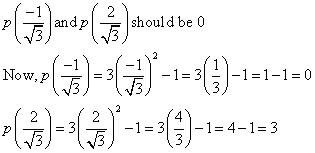
Hence, is a zero of given polynomial but
is not a zero of given
polynomial.
(viii) If is a zero of polynomial p(x) = 2x + 1 then
should be 0.

So, is not a zero of polynomial.
Concept Insight: Key idea here is Zero of the polynomial is not the real number zero but it is that value of the variable which makes the value of the polynomial equal to zero. A polynomial can have more than one zeroes.
Solution 4
Zero of a polynomial is that value of variable at which value of polynomial comes to 0.
(i) p(x) = x + 5
p(x) = 0
x + 5 = 0
x = - 5
So, for x = - 5, value of polynomial is 0 and hence x = - 5 is a zero of polynomial.
(ii) p(x) = x - 5
p(x) = 0
x - 5 = 0
x = 5
So, for x = 5 value of polynomial is 0 and hence x = 5 is a zero of polynomial.
(iii) p(x) = 2x + 5
p(x) = 0
2x + 5 = 0
2x = - 5
So, for value of polynomial is 0 and hence
is a zero of polynomial.
(iv) p(x) = 3x - 2
p(x) = 0
3x - 2 = 0
So, for , value of polynomial is 0 and hence
is a zero of polynomial.
(v) p(x) = 3x
p(x) = 0
3x = 0
x = 0
So, for x = 0 value of polynomial is 0 and hence x = 0 is a zero of polynomial.
(vi) p(x) = ax
p(x) = 0
ax = 0
x = 0
So, for x = 0, value of polynomial is 0. Hence x = 0 is a zero of polynomial.
(vii) p(x) = cx + d
p(x) = 0
cx+ d = 0
So, for , value of polynomial is 0. Hence
is a zero of polynomial.
Concept Insight: Equate the polynomial to zero and solve the corresponding linear equation to get the value of variable. Be careful while transposing the terms to the other side. For verification substitute the value of the variable obtained in the polynomial.
Chapter 2 - Polynomials Exercise Ex. 2.3
Solution 1
Let p(x) = x3 + 3x2 + 3x + 1.
(i) x + 1
Zero of x +1 is-1.
i.e. p(-1) = (- 1)3 + 3 (- 1)2 + 3 (-1) + 1 = 0
So, the remainder is 0.
(ii)
Zero of is
![]()
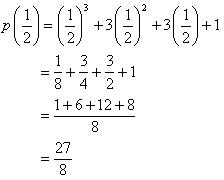
(iii) x
Zero of x is 0.
p(0) = (0)3 + 3(0)2 + 3(0) + 1 = 1
So, the remainder is 1.
(iv) x + ![]()
Zero of x + ![]() is:
is:
x + ![]() = 0
= 0 ![]() x = -
x = - ![]()
p (- ![]() ) = (-
) = (- ![]() )3 + 3(-
)3 + 3(- ![]() )2 + 3(-
)2 + 3(- ![]() ) + 1 = -
) + 1 = - ![]() 3 + 3
3 + 3 ![]() 2 - 3
2 - 3![]() + 1
+ 1
So, the remainder is - ![]() 3 + 3
3 + 3 ![]() 2 - 3
2 - 3![]() + 1
+ 1
(v) 5 + 2x
Zero of 5+2x is:
5 + 2x = 0 ![]() 2x = - 5
2x = - 5
i.e. x = - ![]()
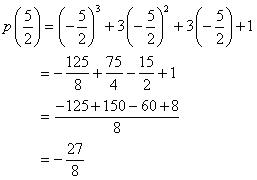
OR
(i) x + 1
By long division
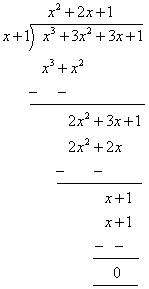
So, remainder is 0.
(ii).
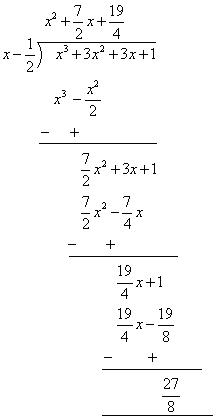
So, remainder is![]() .
.
(iii) x
By long division
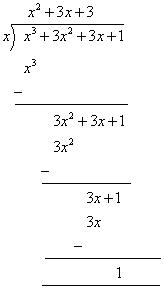
So, remainder is 1.
(iv) x + ![]()
By long division
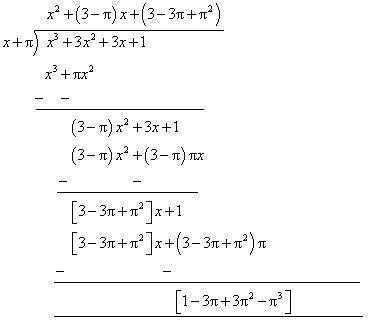
So, the remainder is
(v) 5 + 2x
By long division
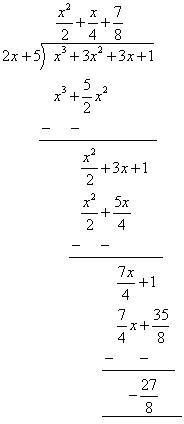
So the remainder is -![]() .
.
Concept Insight: The remainder of any polynomial p(x) when divided by another polynomial (ax+b) where a and b are real numbers ![]() is p(-b/a).
is p(-b/a).
Note that here -b/a is the zero of polynomial ax+b.
This problem can also be solved using long division. For long division first write the divisor and dividend in the standard form, i.e. arrange the terms in the descending order of their powers. The process of division is continued till the remainder is constant or the degree of new dividend is less than the degree of divisor. Do not forget to change the sign of terms while subtraction. For cross verification division algorithm
Dividend = Quotient![]() Divisor + Remainder can be used.
Divisor + Remainder can be used.
Solution 2
According to the remainder theorem, if p(x) is any polynomial of degree![]() 1 and a is any real number, then when p(x) is divided by the linear polynomial x - a, then the remainder is p(a).
1 and a is any real number, then when p(x) is divided by the linear polynomial x - a, then the remainder is p(a).
Here p(x) = x3 - ax2 + 6x - a
p(a) = (a)3 - a(a)2 + 6a - a
= 5a
So when x3 - ax2 + 6x - a is divided by x - a, remainder comes to 5a.
OR
By long division
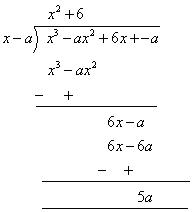
So when x3 - ax2 + 6x - a is divided by x - a, remainder comes to 5a.
Concept Insight: The remainder of any polynomial p(x) when divided by another polynomial (ax+b) where a and b are real numbers ![]() is
is
p(-b/a).
Note that here -b/a is the zero of polynomial ax+ b.
This question can also be solved using long division method however it is long and time consuming. Chances of making computational error are high in that method.
Solution 3
Zero of 7 + 3x is:
7 + 3x = 0
Therefore,
7+3x can be a factor of p(x) = 3x3 + 7x only if
Here p(x) = 3x3 + 7x
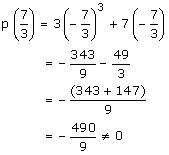
7 + 3x is not a factor of 3x3 + 7x.
OR
Let us divide (3x3 + 7x) by (7 + 3x). If remainder comes out to be 0 then 7 + 3x will be a factor of
3x3 + 7x.
By long division
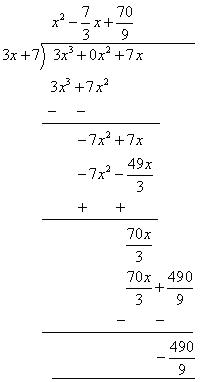
As remainder is not zero so 7 + 3x is not a factor of 3x3 + 7x.
Concept Insight: Any linear polynomial 'ax+b' where a and b are real numbers ![]() is a factor of the polynomial p(x) iff p(-b/a) = 0 i.e -b/a is a zero of p(x) or both the polynomials has a common zero -b/a. This question can also be solved using long division method. Do not forget to change the sign of terms while subtraction in the long division.
is a factor of the polynomial p(x) iff p(-b/a) = 0 i.e -b/a is a zero of p(x) or both the polynomials has a common zero -b/a. This question can also be solved using long division method. Do not forget to change the sign of terms while subtraction in the long division.
Chapter 2 - Polynomials Exercise Ex. 2.4
Solution 1
(i) If (x + 1) is a factor of p(x) = x3 + x2 + x + 1, p (- 1) must be zero.
Here, p(x) = x3 + x2 + x + 1
p(-1) = (- 1)3 + (- 1)2 + (- 1) + 1
= - 1 + 1 - 1 + 1 = 0
Hence, x + 1 is a factor of this polynomial
(ii) If (x + 1) is a factor of p(x) = x4 + x3 + x2 + x + 1, p (- 1) must be zero.
Here, p(x) = x4 + x3 + x2 + x + 1
p( -1) = (- 1)4 + (- 1)3 + (- 1)2 + (- 1) + 1
= 1 - 1 + 1 -1 + 1 = 1
As, ![]()
So, x + 1 is not a factor of this polynomial
(iii) If (x + 1) is a factor of polynomial p(x) = x4 + 3x3 + 3x2 + x + 1, p(- 1) must be 0.
p(- 1) = (- 1)4 + 3(- 1)3 + 3(- 1)2 + (- 1) + 1
= 1 - 3 + 3 - 1 + 1 = 1
As, ![]()
So, x + 1 is not a factor of this polynomial
(iv) If (x + 1) is a factor of polynomial
p(x) = , p(- 1) must be 0.

As, ![]()
So, (x + 1) is not a factor of this polynomial.
Concept Insight: A linear polynomial 'x-a' is a factor of the polynomial p(x) iff p(a) = 0. Note that 'a' is a zero of polynomials x-a and p(x) . Be careful while squaring and cubing the numbers.
Solution 2
(i) If g(x) = x + 1 is a factor of given polynomial p(x), p(- 1) must be zero.
p(x) = 2x3 + x2 - 2x - 1
p(- 1) = 2(- 1)3 + (- 1)2 - 2(- 1) - 1
= 2(- 1) + 1 + 2 - 1 = 0
Hence, g(x) = x + 1 is a factor of given polynomial.
(ii) If g(x) = x + 2 is a factor of given polynomial p(x), p(- 2) must be 0.
p(x) = x3 +3x2 + 3x + 1
p(- 2) = (- 2)3 + 3(- 2)2 + 3(- 2) + 1
= - 8 + 12 - 6 + 1
= - 1
![]()
Hence g(x) = x + 2 is not a factor of given polynomial.
(iii) If g(x) = x - 3 is a factor of given polynomial p(x), p(3) must be 0.
p(x) = x3 - 4 x2 + x + 6
p(3) = (3)3 - 4(3)2 + 3 + 6
= 27 - 36 + 9 = 0
So, g(x) = x - 3 is a factor of given polynomial.
Concept Insight: The problem is a direct application of Factor theorem. g(x) will be the factor of the polynomial p(x) iff the zero of the linear polynomial g(x) when put in place of the variable of polynomial results to zero. Be careful while squaring and cubing the numbers.
Solution 3
If x - 1 is a factor of polynomial p(x), then p(1) = 0
(i) p(x) = x2 + x + k
p(1) = 0![]() (1)2 + 1 + k = 0
(1)2 + 1 + k = 0
![]() 2 + k = 0
2 + k = 0
![]() k = - 2
k = - 2
So, value of k is - 2.
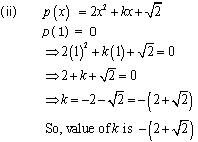
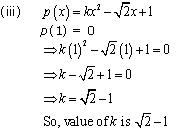
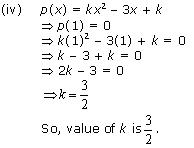
Concept Insight: x-1 is a factor of the given polynomial p(x) iff p(1) = 0 thus equating p(1) to zero will give the required value of constant k. Be careful with arithmetic simplifications.
Solution 4
(i) 12x2 - 7x + 1
The two numbers such that pq = 12![]() 1 = 12 and p + q = - 7. They are p = - 4 and
1 = 12 and p + q = - 7. They are p = - 4 and
q = - 3
Now, 12x2 - 7x + 1 = 12x2 - 4x - 3x + 1
= 4x (3x - 1) - 1 (3x - 1)
= (3x - 1) (4x - 1)
(ii) 2x2 + 7x + 3
The two numbers such that pq = 2![]() 3 = 6 and p + q = 7.
3 = 6 and p + q = 7.
They are p = 6 and q = 1
Now, 2x2 + 7x + 3 = 2x2 + 6x + x + 3
= 2x (x + 3) + 1 (x + 3)
= (x + 3) (2x+ 1)
(iii) 6x2 + 5x - 6
The two numbers such that pq = - 36 and p + q = 5.
They are p = 9 and q = - 4
Now,
6x2 + 5x - 6 = 6x2 + 9x - 4x - 6
= 3x (2x + 3) - 2 (2x + 3)
= (2x + 3) (3x - 2)
(iv) 3x2 - x - 4
The two numbers such that pq = 3![]() (- 4) = - 12
(- 4) = - 12
and p + q = - 1.
They are p = - 4 and q = 3.
Now,
3x2 - x - 4 = 3x2 - 4x + 3x - 4
= x (3x - 4) + 1 (3x - 4)
= (3x - 4) (x + 1)
Concept Insight: To factorise the polynomial ax2+bx+c, by splitting the middle term,
b is expressed as the sum of two numbers whose product is ac.
Do not forget to consider the sign of the terms while splitting.
Remember
| ac>0 | b>0 | b =(p+q) where p>0,q>0 |
| ac>0 | b<0 | b =(p+q) where p<0,q<0 |
| ac<0 | b>0 | b =(p+q) where |
| ac<0 | b<0 | b =(p+q) where |
Solution 5
(i) Let p(x) = x3 - 2x2 - x + 2
Factors of 2 are 1, 2.
By hit and trial method
p(2) = (2)3 - 2(2)2 - 2 + 2
= 8 - 8 - 2 + 2 = 0
So, (x - 2) is factor of polynomial p(x)
By long division
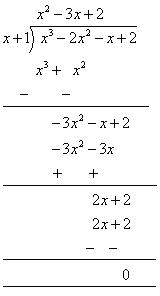
Now, Dividend = Divisor![]() Quotient + Remainder
Quotient + Remainder
x3 - 2x2 - x + 2 = (x + 1) (x2 - 3x + 2) + 0
= (x + 1) [x2 - 2x - x + 2]
= (x + 1) [x (x - 2) - 1 (x - 2)]
= (x + 1) (x - 1) (x - 2)
= (x - 2) (x - 1) (x + 1)
(ii) Let p(x) = x3 - 3x2 - 9x - 5
Factors of 5 are 1, 5.
By hit and trial method
p(- 1) = (- 1)3 - 3(- 1)2 - 9(- 1) - 5
= - 1 - 3 + 9 - 5 = 0
So x + 1 is a factor of this polynomial
Let us find the quotient while dividing x3 + 3x2 - 9x - 5 by x + 1
By long division

Now, Dividend = Divisor![]() Quotient + Remainder
Quotient + Remainder
x3 - 3x2 - 9x - 5 = (x + 1) (x2 - 4 x - 5) + 0
= (x + 1) (x2 - 5 x + x - 5)
= (x + 1) [(x (x - 5) +1 (x - 5)]
= (x + 1) (x - 5) (x + 1)
= (x - 5) (x + 1) (x + 1)
(iii) Let p(x) = x3 + 13x2 + 32x + 20
The factors of 20 are 1, 2, 4, 5 ... ...
By hit and trial method
p(- 1) = (- 1)3 + 13(- 1)2 + 32(- 1) + 20
= - 1 + 13 - 32 + 20
= 33 - 33 = 0
As p(-1) is zero, so x + 1 is a factor of this polynomial p(x).
Let us find the quotient while dividing x3 + 13x2 + 32x + 20 by (x + 1)
By long division
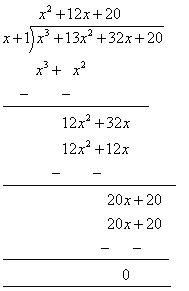
We know that
Dividend = Divisor![]() Quotient + Remainder
Quotient + Remainder
x3 + 13x2 + 32x + 20 = (x + 1) (x2 + 12x + 20) + 0
= (x + 1) (x2 + 10x + 2x + 20)
= (x + 1) [x (x + 10) + 2 (x + 10)]
= (x + 1) (x + 10) (x + 2)
= (x + 1) (x + 2) (x + 10)
(iv) Let p(y) = 2y3 + y2 - 2y - 1
By hit and trial method
p(1) = 2 ( 1)3 + (1)2 - 2( 1) - 1
= 2 + 1 - 2 - 1= 0
So, y - 1 is a factor of this polynomial
By long division method,
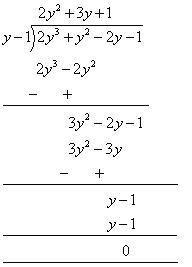
p(y) = 2y3 + y2 - 2y - 1
= (y - 1) (2y2 +3y + 1)
= (y - 1) (2y2 +2y + y +1)
= (y - 1) [2y (y + 1) + 1 (y + 1)]
= (y - 1) (y + 1) (2y + 1)
Concept Insight: To factorise p(x) when its degree is greater than or equal to 3 note down all the factors of constant term considering both negative and positive sign.
Check the obtained factors for the possible zeroes of the polynomial p(x) Using Factor theorem one zero can be obtained continue the process till all the zeroes are obtained or use long division method. To obtain the other quadratic factor use long division to determine the other factors. The degree of the polynomial is less than or equal to the number of real factors the polynomial.
Chapter 2 - Polynomials Exercise Ex. 2.5
Solution 1
(i). By using identity

(ii). By using identity

(iii).
By using the identity
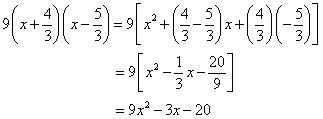
(iv). By using identity

(v). By using identity

Concept Insight: If the value of the two terms of the binomials are equal then use the algebraic identity (x+a) (x-a) = x2 - a2 else use (x+a) (x+b) = x2+(a+b)x+ab to obtain required product.
Solution 2
(i). 103![]() 107 = (100 + 3) (100 + 7)
107 = (100 + 3) (100 + 7)
= (100)2 + (3 + 7) 100 + (3) (7)
[By using the identity, , where
x = 100, a = 3 and b = 7]
= 10000 + 1000 + 21
= 11021
(ii). 95![]() 96 = (100 - 5) (100 - 4)
96 = (100 - 5) (100 - 4)
= (100)2 + (- 5 - 4) 100 + (- 5) (- 4)
[By using the identity, , where
x = 100, a = - 5 and b = - 4]
= 10000 - 900 + 20
= 9120
(iii). 104![]() 96 = (100 + 4) (100 - 4)
96 = (100 + 4) (100 - 4)
= (100)2 - (4)2
= 10000 - 16
= 9984
Concept Insight: The key is to use the algebraic identity (x+a) (x+b) = x2+(a+b)x+ab or (x+a) (x-a) = x2 - a2 for such questions. Write each of the numeral as 100 k , or any other suitable number whose square can be easily computed.
Solution 3
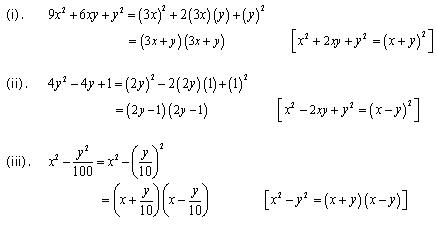
Concept Insight: Use the appropriate square identity. If the polynomial has only two terms, reduce each term to the perfect square and use the algebraic identity ![]() . When the polynomial has three terms and the term having
. When the polynomial has three terms and the term having
unit power of each variable has negative sign use the square identity ![]() else use
else use ![]() .
.
Solution 4
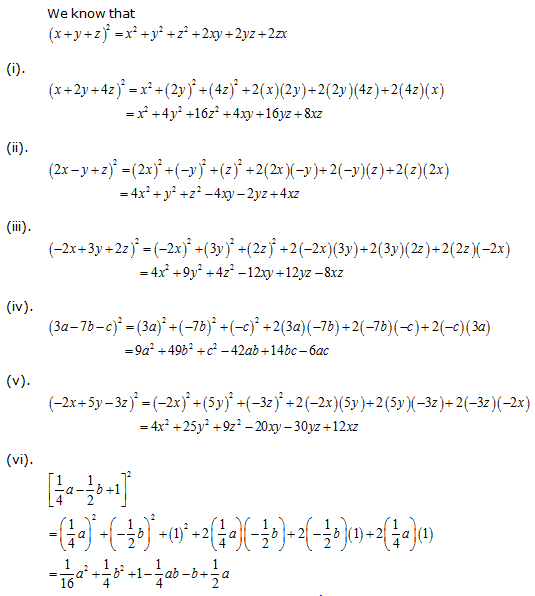
Concept Insight: Use the algebraic identity ![]()
. Do consider the sign of terms while multiplying and squaring.
Solution 5
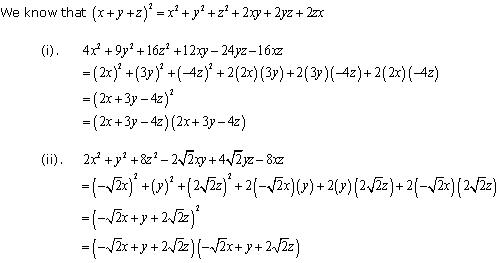
Concept Insight: Use the algebraic identity ![]()
in the reverse order. Write each term as per the terms of the standard identity. Do consider the sign of terms involved.
Solution 6
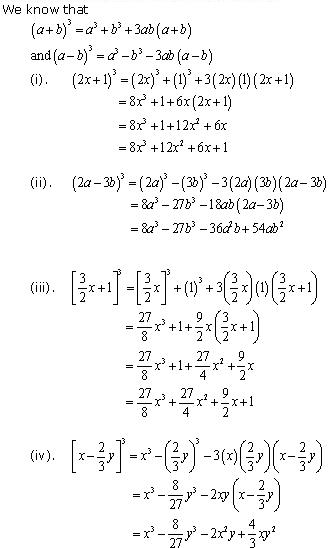
Concept Insight: Since the expressions involves cube so cubic identity will be used. If the terms of the given polynomial are separated by positive sign use the identity ![]() or if negative signs are used then use
or if negative signs are used then use ![]() . Carefully apply the mathematical operations.
. Carefully apply the mathematical operations.
Solution 7
We know that

(i) (99)3 = (100 - 1)3
= (100)3 - (1)3 - 3(100) (1) (100 - 1)
= 1000000 - 1 - 300(99)
= 1000000 - 1 - 29700
= 970299
(ii) (102)3 = (100 + 2)3
= (100)3 + (2)3 + 3(100) (2) (100 + 2)
= 1000000 + 8 + 600 (102)
= 1000000 + 8 + 61200
= 1061208
(iii) (998)3 = (1000 - 2)3
= (1000)3 - (2)3 - 3(1000) (2) (1000 - 2)
= 1000000000 - 8 - 6000(998)
= 1000000000 - 8 - 5988000
= 1000000000 - 5988008
= 994011992
Concept Insight: Use the cubic identity ![]() and
and ![]() . Write the numerical term as something added or
. Write the numerical term as something added or
subtracted from 10,100, 1000 or higher powers of 10 as it's easy to compute higher powers of 10. Carefully apply the mathematical operations.
Solution 8
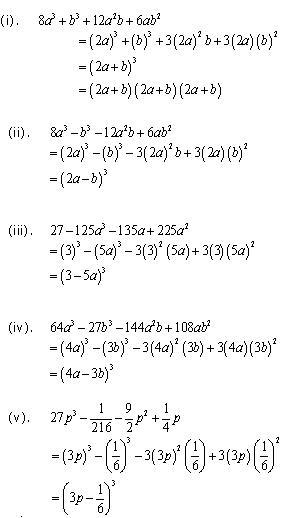
Concept Insight: Since all the polynomial given here have degree 3 so cubic identities would be used here. Now if all the terms of the given polynomial are positive then use identity ![]() while if any two terms has negative sign reduce each of
while if any two terms has negative sign reduce each of
the term of the polynomial as per the standard cubic identity ![]() .
.
Solution 9
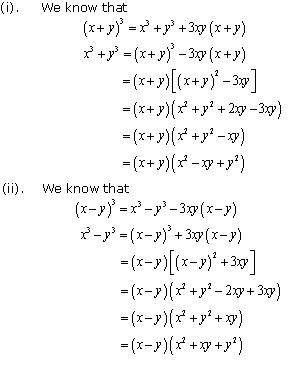
Concept Insight: When the two terms of the polynomial are separated by positive sign use the identity ![]() and when by negative sign use
and when by negative sign use ![]() .
.
Carefully take the common term out.
Solution 10
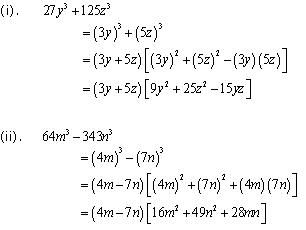
Concept Insight: Reduce the terms of the polynomial to perfect cube and then if the two terms of the polynomial are separated by positive sign use the identity ![]() and when by negative sign use
and when by negative sign use ![]() .
.
Solution 11
We Know that

Concept Insight: Reduce each terms of the polynomial as per the left hand side of the standard identity, .
Solution 12
We know that

Concept Insight: Since the left hand side of the identity resembles the left hand side of identity, , so this identity
will be applicable here. Now the right hand side of the above identity can be written into many forms we need to look at what is required to proved, Accordingly apply mathematical simplifications and square identities to get the desired result.
Solution 13

Concept Insight: Use the result that ![]() for x + y + z = 0.
for x + y + z = 0.
Solution 14
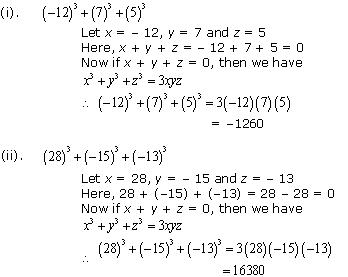
Concept Insight: Use the result ![]() since x + y + z = 0. Also consider the
since x + y + z = 0. Also consider the
sign of the term. Carefully do the computation.
Solution 15
We know that,
Area = length![]() breadth
breadth
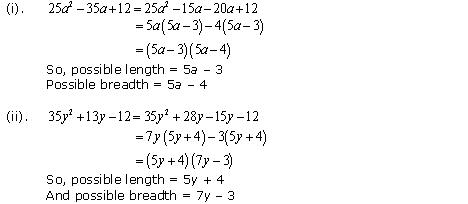
Concept Insight: For such questions factorise the expression, given for the area of rectangle by splitting the middle term. One of its factors will be its length and the other will be its breadth.
Solution 16
We know that,
Volume of cuboid = length![]() breadth
breadth![]() height
height
(i).
So, the possible solutions is
Length = 3, breadth = x, height = x - 4
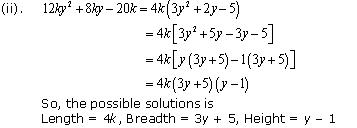
Concept Insight: For such questions factorise the expression, given for the volume of the cuboid by taking the common term out if it has two terms and by splitting the middle term if the polynomial has three terms. Three factors obtained will be its length breadth and height.
Mathematics Form 1 Chapter 2 Exercise With Answers
Source: https://www.topperlearning.com/ncert-solutions/cbse-class-9-mathematics/mathematics-ix/polynomials
Posted by: holleyseentrusels.blogspot.com

0 Response to "Mathematics Form 1 Chapter 2 Exercise With Answers"
Post a Comment